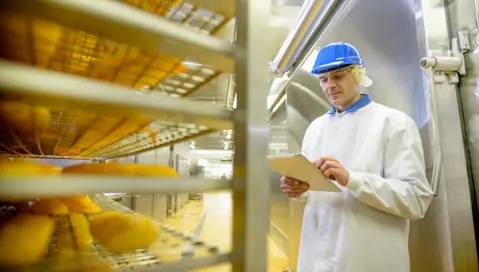6 Strategies for Better Product Shelf Life Management
6 Strategies for Better Product Shelf Life Management
6 Strategies for Better Product Shelf Life Management
9 Feb 2022
Jack Payne
Working in the food and beverage industry, you know that time is of the essence. Your customers expect products to be fresh, and you’ve got inventory that needs to move before it spoils and becomes unfit for sale. To accomplish this, you need to know the expiration dates of all of your materials and time their usage and distribution accordingly.
But when your warehouse is packed to the gills with a variety of ingredients and your suppliers vary greatly in the freshness of the goods they deliver to you, how can you possibly hope to keep things straight? It can seem like a never-ending scramble to update your records and get shipments out the door in time—but it doesn’t have to be.
While it will always require effort on the part of your staff, product shelf life management is much easier to master if you put certain measures in place and couple them with modern technology. Read on for six key strategies that will unlock savings, minimize waste and lead to greater customer satisfaction.
1. Apply First-Expiry, First-Out Inventory Logic
It follows that, given many individual items in stock that vary by expiration date, you should opt to always use the next to expire when pulling materials for a production run or order. Still, some companies continue to use a first-in, first-out (FIFO) method for picking out of convenience instead of the more ideal first-expiry, first-out (FEFO) approach.
Using FEFO inventory logic will not only reduce losses due to spoilage—which leads to savings, as you’ll get more out of what you purchase—but it also helps you deliver products to consumers that are valid for longer. Of course, it also necessitates having all of your expiration dates logged and highly accessible, and that’s prohibitively cumbersome to do by hand.
That, however, leads us to our next tip…
2. Implement Integrated Business Software
Gone are the days when Microsoft Excel spreadsheets—let alone paper charts—could cut it for proper inventory control at your food and beverage business. There’s too much room for human error when using those means, and it’s far too time-intensive to be an efficient method for logging all of the critical product data that you need.
Thankfully, purpose-built technology has been developed to manage the matters of information capture and database maintenance. The best among the offerings on the market are industry-specific enterprise resource planning (ERP) systems, as they don’t just serve to track your inventory. These are powerful, all-in-one platforms that help every department in your organization and drive holistic company-wide improvement.
The fully digital and integrated nature of ERP is a distinct advantage, as you can leverage complementary solutions and devices for even more streamlined operations all from one interface. From smart sensors and scales to connected manufacturing equipment, you always have the latest updates and can flag deviations and observe trends in real time.
3. Use Information-Rich Barcodes
When it comes to expediting data capture, barcodes (or, alternatively, QR codes) are a game-changer. Tons of information can be contained in mere inches, and it can all be imported into your system with a single scan, making the process efficient and error-free.
What’s more, using barcodes that adhere to GS1 standards facilitates the capture of your all-important expiration dates, so that’s something worth establishing between your company and your suppliers. And back on the topic of integrations offered by ERP, syncing up with handheld scanners for instantaneous import of vital product data is another significant benefit of this advanced software.
4. Manage Suppliers Optimally
We mentioned at the outset that different suppliers will provide goods with different windows of viability, and it’s even likely that some individual vendors will be inconsistent from shipment to shipment. While you may not be able to directly control the date ranges of what you receive, you can—and should—negotiate for terms that align with what is actually provided and implement pre-receipt quality checks to vet incoming shipments.
Food ERP helps manage relationships with suppliers through a fully configurable backend that allows for the addition and removal of supply chain partners, as well as the codification of your contracts with them. With that level of control, you can feel confident that you’re paying the right price for the materials you purchase.
5. Seek Sales Opportunities for Short-Dated Products
Even with the four above strategies deployed, your business is bound to end up with unsold items that are nearing their expiration date and need to be sold right away in order to recoup even a portion of the expenses that went into their production. The old-fashioned approach of offering a discount on the price and calling up potential buyers to make a deal is certainly still a suitable tactic to accomplish that goal.
Here again the supply chain management functions of an ERP solution can come in handy, as they allow you to introduce new clients easily within the platform so that sales can be made. They also provide precise pricing tools that make calculating your discounts and scrutinizing your profit margins much easier.
6. Analyze Patterns and Adjust Purchasing
Even if you think that your purchasing plans are serving your organization well, it’s in your best interest to crunch the numbers and review the results you’re achieving. You may find that waste is still too high and decide to revisit your shelf life inventory management procedures, or you might decide that one supplier is more reliable in terms of the freshness of the products they deliver.
Robust financial analytics are yet another crucial component of ERP software, and they can create data visualizations that paint a picture of your performance better than any revenue report can. This, in turn, facilitates informed decision-making that can lead to even greater successes down the road.
Improving Your Product Shelf Life Management Today
It’s clear from what we’ve explored in this piece that better shelf life management processes can unlock greater visibility of data, higher profitability and better customer experiences. An ERP platform made specifically for food and beverage companies like yours is key to make sure you reap all these rewards from your efforts, though, as only with that technological foundation can you take advantage of the strategies discussed here.
Our own industry-specific food and beverage solution, Aptean Food & Beverage ERP, regularly beats out the competition because it was designed with decades of collective industry knowledge and a deep understanding of best practices, including those that relate to getting the most out of your materials. Our system is fully scalable, and we offer flexible cloud deployments in addition to traditional on-premise setups for organizations that want to maximize accessibility and mobile capabilities.
Need another reason to consider Aptean for your software solution needs? We were recently awarded Frost & Sullivan’s 2022 Product Leadership Award in North American ERP Software for the Food and Beverage Industry, which stands as a testament to how our offerings help clients bring their digital transformations to full fruition.
Ready to learn more about Aptean Food & Beverage ERP and the tools it has for product shelf life management? Contact us or request a personalized demo.
¿Todo listo para transformar tu negocio?
Tenemos las soluciones ERP especializadas que necesitas para superar los desafíos de tu sector.



